Page 46 of 304
46 Getting startedDrivingThe coolant temperature is over 248°F
(120°C)
The coolant is too hot and is no longer
cooling the engine.�
Stop the vehicle as soon as possible
and turn off the engine. Allow engine
and coolant to cool.
�
Check the coolant level and add cool-
ant if necessary (
�page 176).In case of accident
If the vehicle is leaking gasoline:
�
Do not start the engine under any cir-
cumstances.
�
Notify local fire and/or police authori-
ties.
If the extent of the damage cannot be de-
termined:
�
Notify an authorized Mercedes-Benz
Center.
If no damage can be determined on the
�
major assemblies
�
fuel system
�
engine mount
�
Start the engine in the usual manner.
Page 103 of 304
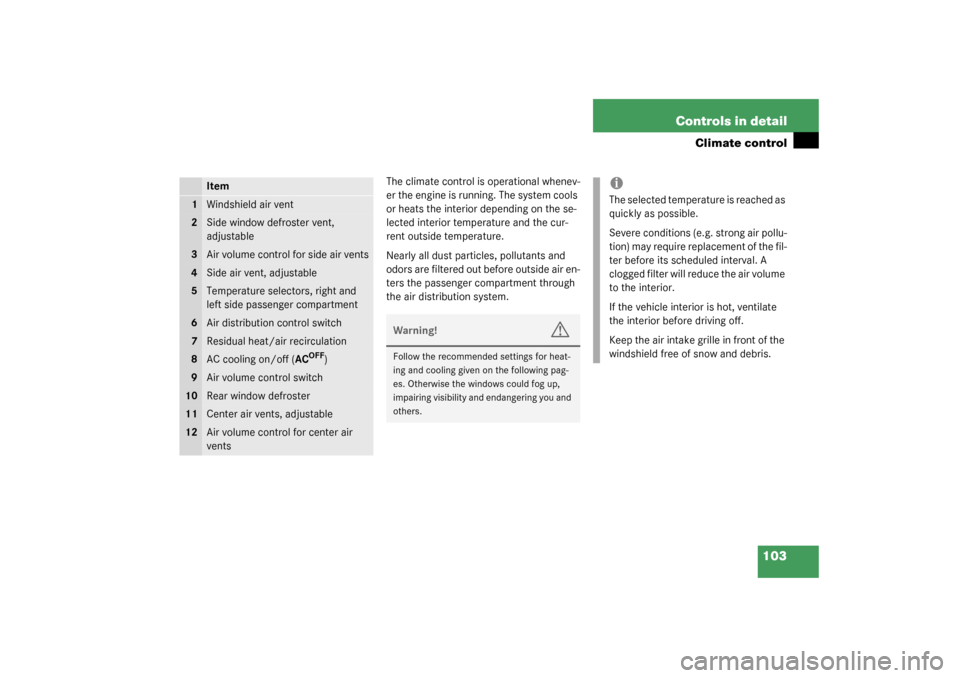
103 Controls in detail
Climate control
The climate control is operational whenev-
er the engine is running. The system cools
or heats the interior depending on the se-
lected interior temperature and the cur-
rent outside temperature.
Nearly all dust particles, pollutants and
odors are filtered out before outside air en-
ters the passenger compartment through
the air distribution system.
Item
1
Windshield air vent
2
Side window defroster vent,
adjustable
3
Air volume control for side air vents
4
Side air vent, adjustable
5
Temperature selectors, right and
left side passenger compartment
6
Air distribution control switch
7
Residual heat/air recirculation
8
AC cooling on/off (AC
OFF
)
9
Air volume control switch
10
Rear window defroster
11
Center air vents, adjustable
12
Air volume control for center air
vents
Warning!
G
Follow the recommended settings for heat-
ing and cooling given on the following pag-
es. Otherwise the windows could fog up,
impairing visibility and endangering you and
others.
iThe selected temperature is reached as
quickly as possible.
Severe conditions (e.g. strong air pollu-
tion) may require replacement of the fil-
ter before its scheduled interval. A
clogged filter will reduce the air volume
to the interior.
If the vehicle interior is hot, ventilate
the interior before driving off.
Keep the air intake grille in front of the
windshield free of snow and debris.
Page 104 of 304
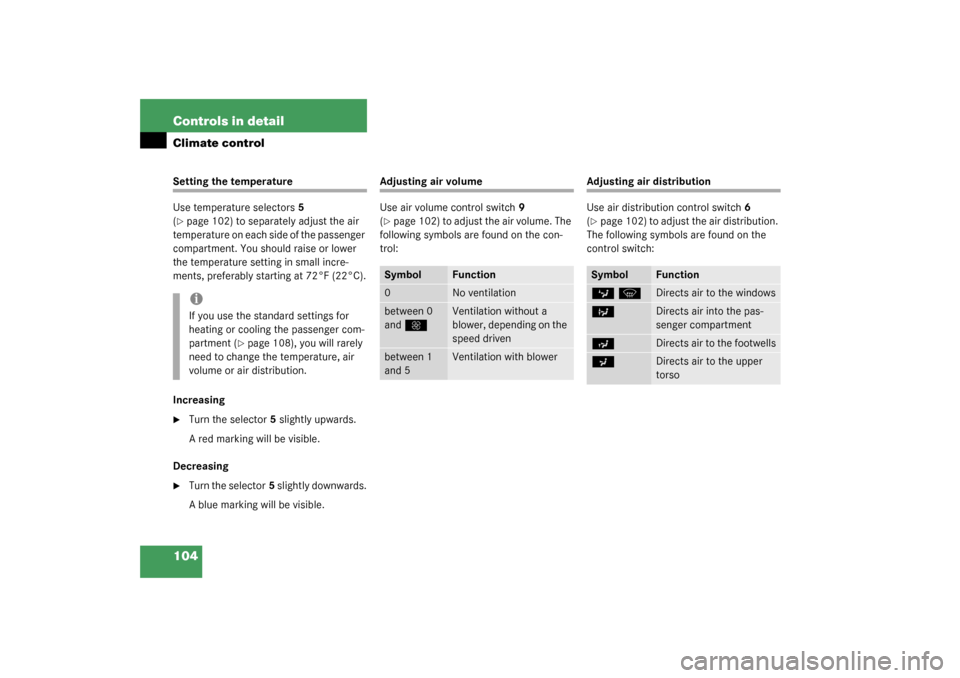
104 Controls in detailClimate controlSetting the temperature
Use temperature selectors5
(�page 102) to separately adjust the air
temperature on each side of the passenger
compartment. You should raise or lower
the temperature setting in small incre-
ments, preferably starting at 72°F (22°C).
Increasing
�
Turn the selector5 slightly upwards.
A red marking will be visible.
Decreasing
�
Turn the selector5 slightly downwards.
A blue marking will be visible.
Adjusting air volume
Use air volume control switch9
(�page 102) to adjust the air volume. The
following symbols are found on the con-
trol:
Adjusting air distribution
Use air distribution control switch6
(�page 102) to adjust the air distribution.
The following symbols are found on the
control switch:
iIf you use the standard settings for
heating or cooling the passenger com-
partment (
�page 108), you will rarely
need to change the temperature, air
volume or air distribution.
Symbol
Function
0
No ventilation
between 0
and
Q
Ventilation without a
blower, depending on the
speed driven
between 1
and 5
Ventilation with blower
Symbol
Function
cP
Directs air to the windows
b
Directs air into the pas-
senger compartment
d
Directs air to the footwells
a
Directs air to the upper
torso
Page 106 of 304
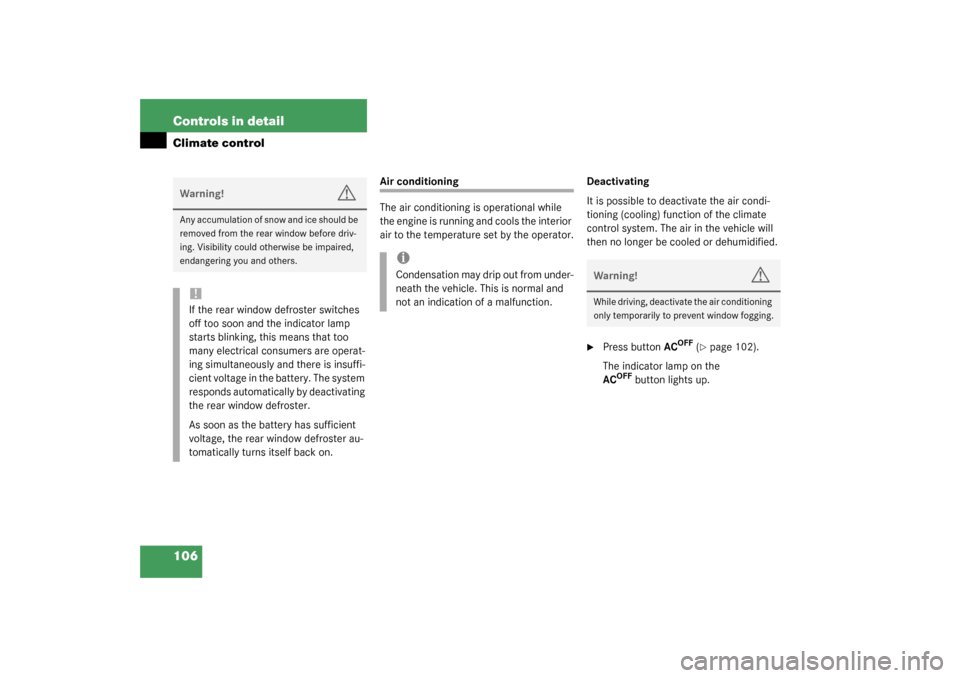
106 Controls in detailClimate control
Air conditioning
The air conditioning is operational while
the engine is running and cools the interior
air to the temperature set by the operator.Deactivating
It is possible to deactivate the air condi-
tioning (cooling) function of the climate
control system. The air in the vehicle will
then no longer be cooled or dehumidified.
�
Press buttonAC
OFF
(�page 102).
The indicator lamp on the
AC
OFF
button lights up.
Warning!
G
Any accumulation of snow and ice should be
removed from the rear window before driv-
ing. Visibility could otherwise be impaired,
endangering you and others.!If the rear window defroster switches
off too soon and the indicator lamp
starts blinking, this means that too
many electrical consumers are operat-
ing simultaneously and there is insuffi-
cient voltage in the battery. The system
responds automatically by deactivating
the rear window defroster.
As soon as the battery has sufficient
voltage, the rear window defroster au-
tomatically turns itself back on.
iCondensation may drip out from under-
neath the vehicle. This is normal and
not an indication of a malfunction.
Warning!
G
While driving, deactivate the air conditioning
only temporarily to prevent window fogging.
Page 176 of 304
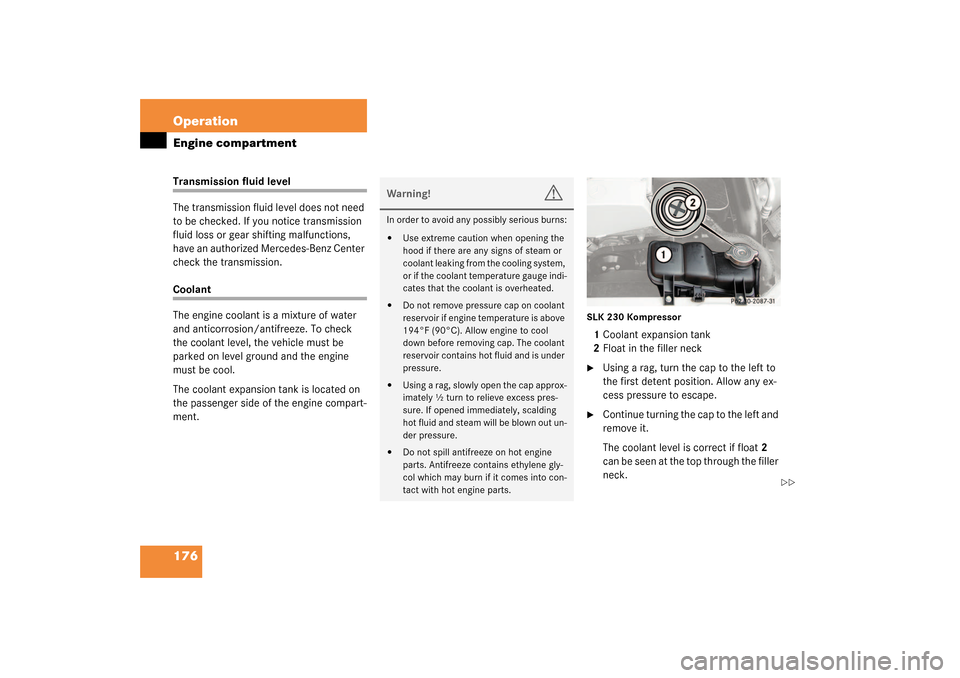
176 OperationEngine compartmentTransmission fluid level
The transmission fluid level does not need
to be checked. If you notice transmission
fluid loss or gear shifting malfunctions,
have an authorized Mercedes-Benz Center
check the transmission.Coolant
The engine coolant is a mixture of water
and anticorrosion/antifreeze. To check
the coolant level, the vehicle must be
parked on level ground and the engine
must be cool.
The coolant expansion tank is located on
the passenger side of the engine compart-
ment.
SLK 230 Kompressor1Coolant expansion tank
2Float in the filler neck�
Using a rag, turn the cap to the left to
the first detent position. Allow any ex-
cess pressure to escape.
�
Continue turning the cap to the left and
remove it.
The coolant level is correct if float2
can be seen at the top through the filler
neck.
Warning!
G
In order to avoid any possibly serious burns:�
Use extreme caution when opening the
hood if there are any signs of steam or
coolant leaking from the cooling system,
or if the coolant temperature gauge indi-
cates that the coolant is overheated.
�
Do not remove pressure cap on coolant
reservoir if engine temperature is above
194°F (90°C). Allow engine to cool
down before removing cap. The coolant
reservoir contains hot fluid and is under
pressure.
�
Using a rag, slowly open the cap approx-
imately ½ turn to relieve excess pres-
sure. If opened immediately, scalding
hot fluid and steam will be blown out un-
der pressure.
�
Do not spill antifreeze on hot engine
parts. Antifreeze contains ethylene gly-
col which may burn if it comes into con-
tact with hot engine parts.
��
Page 177 of 304
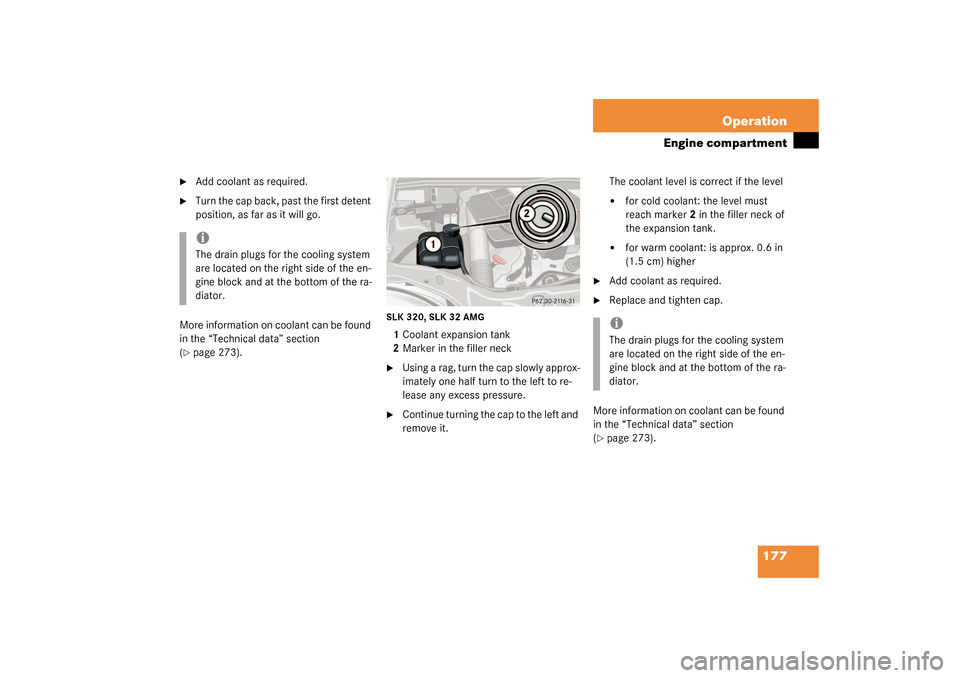
177 Operation
Engine compartment
�
Add coolant as required.
�
Turn the cap back, past the first detent
position, as far as it will go.
More information on coolant can be found
in the “Technical data” section
(
�page 273).
SLK 320, SLK 32 AMG1Coolant expansion tank
2Marker in the filler neck�
Using a rag, turn the cap slowly approx-
imately one half turn to the left to re-
lease any excess pressure.
�
Continue turning the cap to the left and
remove it.The coolant level is correct if the level
�
for cold coolant: the level must
reach marker2 in the filler neck of
the expansion tank.
�
for warm coolant: is approx. 0.6 in
(1.5 cm) higher
�
Add coolant as required.
�
Replace and tighten cap.
More information on coolant can be found
in the “Technical data” section
(
�page 273).
iThe drain plugs for the cooling system
are located on the right side of the en-
gine block and at the bottom of the ra-
diator.
iThe drain plugs for the cooling system
are located on the right side of the en-
gine block and at the bottom of the ra-
diator.
Page 201 of 304
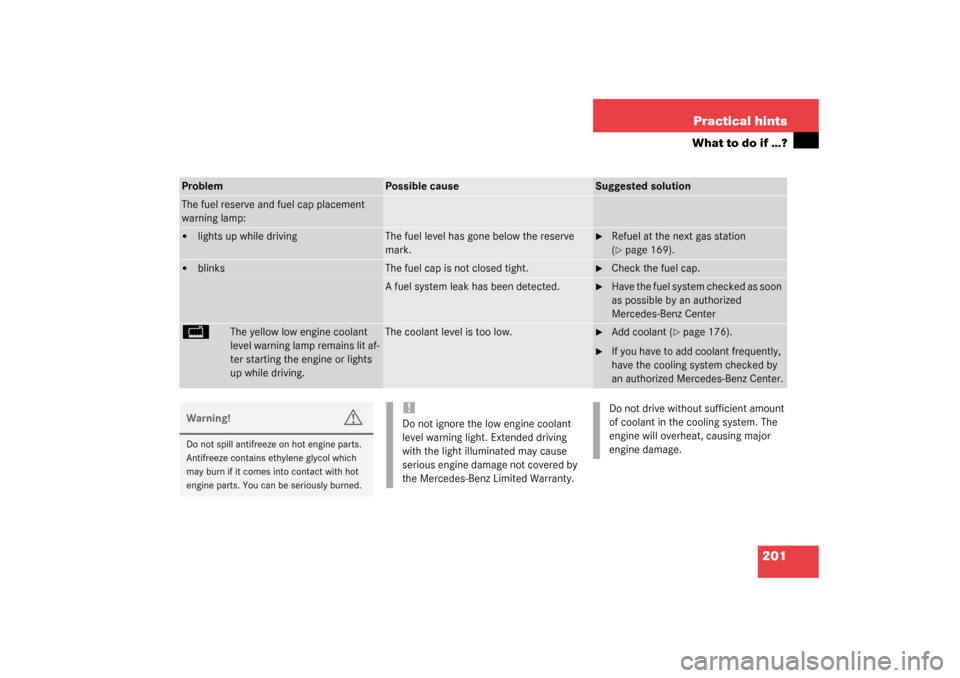
201 Practical hints
What to do if …?
Problem
Possible cause
Suggested solution
The fuel reserve and fuel cap placement
warning lamp:�
lights up while driving
The fuel level has gone below the reserve
mark.
�
Refuel at the next gas station
(�page 169).
�
blinks
The fuel cap is not closed tight.
�
Check the fuel cap.
A fuel system leak has been detected.
�
Have the fuel system checked as soon
as possible by an authorized
Mercedes-Benz Center
B
The yellow low engine coolant
level warning lamp remains lit af-
ter starting the engine or lights
up while driving.
The coolant level is too low.
�
Add coolant (
�page 176).
�
If you have to add coolant frequently,
have the cooling system checked by
an authorized Mercedes-Benz Center.
Warning!
G
Do not spill antifreeze on hot engine parts.
Antifreeze contains ethylene glycol which
may burn if it comes into contact with hot
engine parts. You can be seriously burned.
!Do not ignore the low engine coolant
level warning light. Extended driving
with the light illuminated may cause
serious engine damage not covered by
the Mercedes-Benz Limited Warranty.
Do not drive without sufficient amount
of coolant in the cooling system. The
engine will overheat, causing major
engine damage.
Page 269 of 304
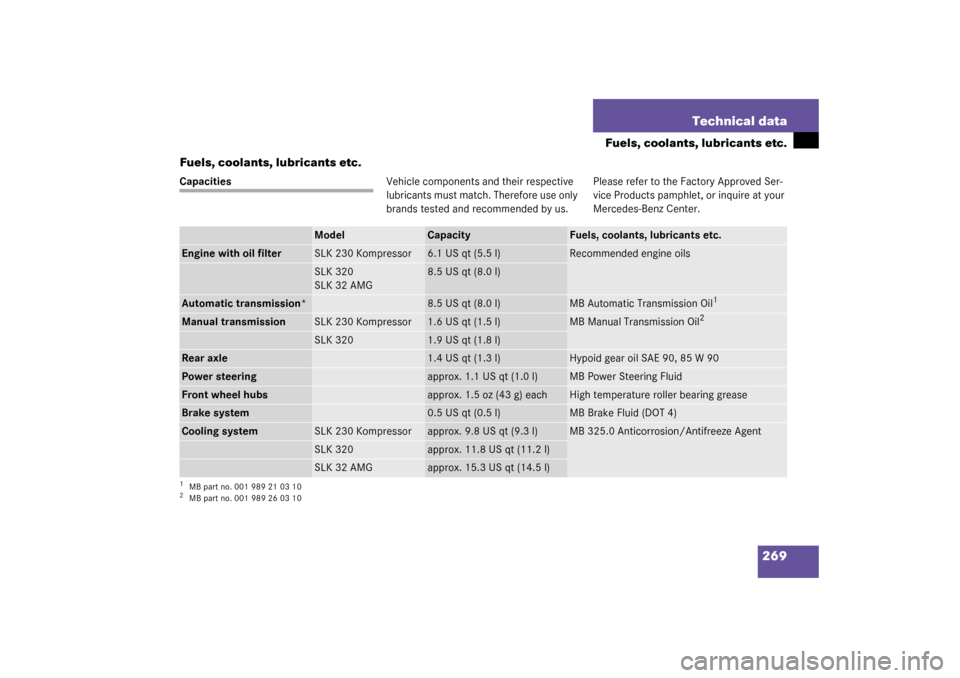
269 Technical data
Fuels, coolants, lubricants etc.
Fuels, coolants, lubricants etc.
CapacitiesVehicle components and their respective
lubricants must match. Therefore use only
brands tested and recommended by us.Please refer to the Factory Approved Ser-
vice Products pamphlet, or inquire at your
Mercedes-Benz Center.
Model
Capacity
Fuels, coolants, lubricants etc.
Engine with oil filter
SLK 230 Kompressor
6.1 US qt (5.5 l)
Recommended engine oils
SLK 320
SLK 32 AMG
8.5 US qt (8.0 l)
Automatic transmission*
8.5 US qt (8.0 l)
MB Automatic Transmission Oil
1
1MB part no. 001 989 21 03 10Manual transmission
SLK 230 Kompressor
1.6 US qt (1.5 l)
MB Manual Transmission Oil
2
2MB part no. 001 989 26 03 10
SLK 320
1.9 US qt (1.8 l)
Rear axle
1.4 US qt (1.3 l)
Hypoid gear oil SAE 90, 85 W 90
Power steering
approx. 1.1 US qt (1.0 l)
MB Power Steering Fluid
Front wheel hubs
approx. 1.5oz (43g) each
High temperature roller bearing grease
Brake system
0.5 US qt (0.5 l)
MB Brake Fluid (DOT 4)
Cooling system
SLK 230 Kompressor
approx. 9.8 US qt (9.3 l)
MB 325.0 Anticorrosion/Antifreeze Agent
SLK 320
approx. 11.8USqt (11.2l)
SLK 32 AMG
approx. 15.3USqt (14.5l)